It is now possible to purchase pumpkin seeds and grow this healthy, tasty and beautiful fruit not only in the southern regions, but also in temperate latitudes. Many varieties are zoned and can be cultivated in different climatic zones according to years of proven technology.
Material Content:
Pumpkin seeds - the best varieties for open ground
There are about 30 varieties of pumpkins. None of them was used to produce numerous hybrids that differ in shoot length, shape, size and color of the fruit, the structure and taste of the pulp, and the timing of vegetation and storage.
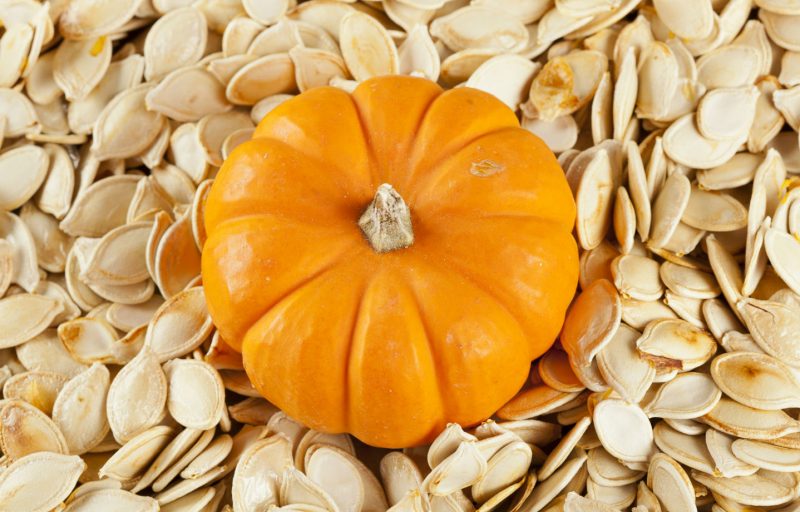
On Russian sites, varieties of hard-bark, or ordinary, pumpkin are cultivated more often than others.
Representatives of this group are very diverse. Among them are climbing and bush forms, medium and early ripe varieties, fruits of various degrees of keeping quality and application.
The best for growing in the temperate zone with hard-bred hybrids are:
- Variety "Plyushka" with medium-sized (1.5 kg) fruits of orange tones, divided by white stripes into segments, and sugary juicy pulp.
- "Gribovskaya Bush" is a hybrid with medium-sized fruits of light orange color, outlined in black and green stripes.
- "Mozolevskaya 49" - a variety with short climbing branches and yellow, in green scalloped stripes, ovoid fruits with a delicious flesh.
Muscat varieties are characterized by medium-sized (6 kg) fruits of rounded flat shape of various shades of green, yellow and orange, covered with a thin, easily cleansed skin.Most nutmeg varieties are characterized by low cold tolerance and a long (up to 130 days) growing season.
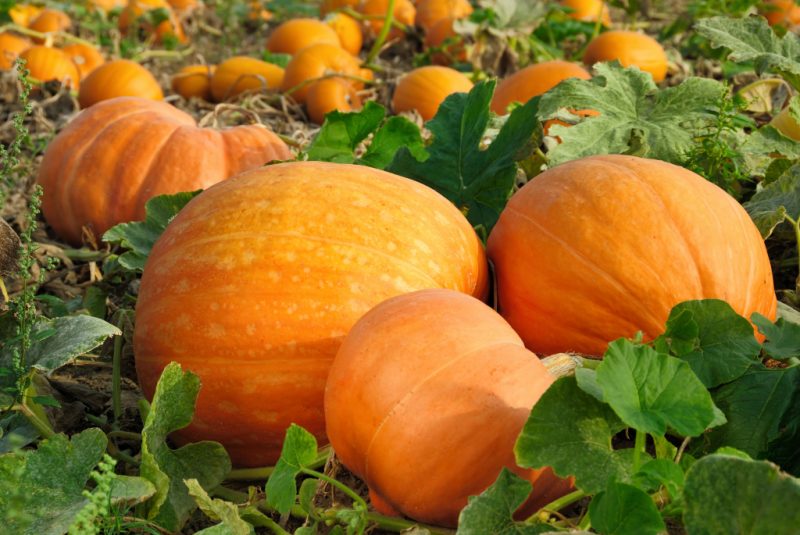
The best muscat hybrids are:
- “Marble Pumpkin” - a variety with greenish-gray fruits, covered with specks, composing a marble pattern, and filled with dense pulp, rich in sugars.
- Variety "Golden Pear" with medium-sized (1.5 - 2 kg) pear-shaped fruits of orange shades with pulp of a pleasant nutty shade.
- Candied Pumpkin is distinguished by its dark green color. When ripe, they change their color to light brown, and the flesh acquires a reddish hue.
Gymnosperm pumpkin is considered one of the most popular varieties of nutmeg, known for its large tasty white seeds.
Large-fruited varieties, and there are about a hundred of them, stand out by record-high sizes of fruits with a thick layer of sweet pulp and resistance to low temperatures.
Popular hybrids of this group are:
- Variety "Lantern" with round smooth slightly ribbed fruits of orange-pink tones and delicate juicy pulp. The fruits are transported and stored for a long time.
- “Russian Porridge” is a bush variety, forming on one plant 3–4 round-shaped fruits, filled with medium-density pulp of high taste.
Some varieties are zoned for cultivation in open ground in certain areas of the Russian Federation. For example, the best hybrids recommended for cultivation in the central part of Russia are considered to be “Baby”, “Sweet Cake”, “Melon”, “Zorka”, “Almond” and “Russian Woman”.
What to look for when choosing seeds
Pumpkin seeds are purchased in stores or harvested on their own.
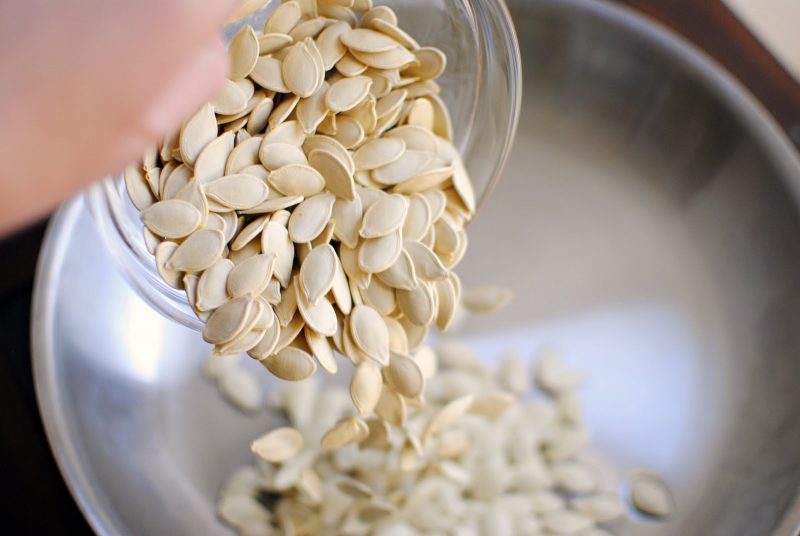
When choosing seeds, it is important:
- Determine the grade. It is made on the basis of an analysis of the climatic conditions of the area, the timing of the growing season of hybrids and plans for the use of fruits.
- Select the highest quality seeds. They should be large, dense, regular in shape and uniform in color and free from damage.
Selected seeds are checked for germination.
There are several ways to do this:
- A small amount of seeds is placed for 15 to 20 minutes. in a small container of water. The specimens remaining after this time on the surface of the water are empty and will not rise.
- A few seeds are wrapped in a moist porous material (gauze, cotton pad, cloth) and put in a warm place for 2 to 3 days. By the number of sprouted seeds, a conclusion is made about their germination.
When buying seed, it is worth asking about its shelf life. Pumpkin seeds retain their germination for 8 to 9 months.
Growing seedlings at home
In temperate latitudes, pumpkin is obtained from seedlings, which are grown indoors.

Pumpkin seeds for seedlings are subjected to treatment designed to accelerate their germination:
- for 2 hours place them in hot (45 ° C) water;
- germinate in a warm (22 - 25 ° C) place, wrapped in moist porous material.
Having prepared the seeds, they begin to sow. To carry it out, containers and substrate are required.
- As containers, boxes or containers are used, on the bottom of which a 3-4 cm layer of sawdust is poured. An alternative is the use of peat cups with a diameter of at least 6 cm. This will avoid the transplant, which pumpkin seedlings carry quite hard.
- The containers are filled with a substrate - purchased universal vegetable soil, recommended for growing cucumbers or a self-prepared mixture of peat, rotted sawdust and humus, taken in a ratio of 2: 1: 1.
- For each kilogram of the mixture add 1 teaspoon of nitrophoska.
- Before sowing, the soil is moistened.
Seeds are planted to a depth of 4 - 5 cm and covered with an airtight transparent material. Tanks with crops are placed in a bright place with daytime temperatures from 18 to 25 ° C, at night 15 - 18 ° C.
Seedlings are looked after:
- regularly and moderately watered, preventing waterlogging and drying out of the soil;
- after 7 to 10 days from the appearance of the sprouts, the seedlings are fed a solution of nitrophoska (15 g per 10 liters of water) or a mullein infused for 3-4 hours (1 part per 10 liters of water), diluted in 5 parts of water.
Young plants 15 to 20 cm high with 2 to 3 true leaves are planted on beds.
How to plant pumpkin seeds in open ground
Planting pumpkin seeds can be carried out immediately in the open ground. This is true for regions with a warm climate. Understanding how to plant a pumpkin in open ground seeds, you should familiarize yourself with some rules.
Landing time frame
According to current belief, pumpkin is sown on St. George's Day (May 25).
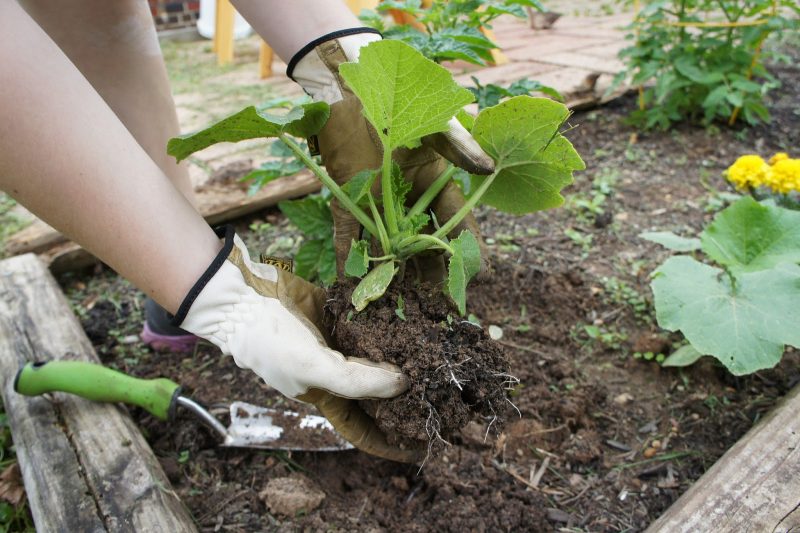
More reliable criteria for selecting the sowing time are temperature conditions. Planting a pumpkin in open ground is possible only after the threat of frost disappears completely, when the average daily air temperature exceeds 20 ° C and the soil warms up sufficiently (at least 10 - 13 ° C).
In the southern regions, this happens around the middle of May, in the middle lane - by the end of this month.
Soil and seed preparation
Before sowing, pumpkin seeds are sorted, checked for germination and soaked.
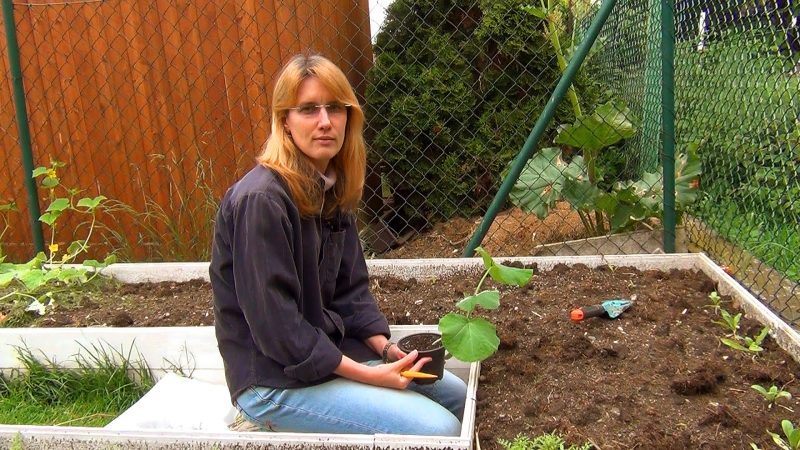
Some vegetable growers practice seed hardening, which is important for growing heat-loving varieties. For this purpose, after swelling and “pecking,” the seed for 2 to 3 days is placed on the lower shelves of the refrigerator.
- With the place of sowing pumpkins are determined in the fall. It is desirable that this is a quickly heated and protected from the wind section, on which perennial grasses or cereals had previously grown.
- In the autumn, the soil in the selected area is dug up (up to 40 cm) and fertilized, introducing for each square meter a manure bucket or nutrient mixture prepared from 200 g of nitrophosphate and 500 g of wood ash mixed with 4 kg of sawdust and 15 kg of humus.
- In the spring, the soil is again dug, harrowed and beds 60 to 70 cm wide are formed.
How to plant a pumpkin
Sowing begins with the marking of beds and the formation of holes with a depth of 40 - 45 cm. For climbing forms, the holes are made in 1.5 - 2 m, and the seeds of bush forms are planted in a nesting manner at a distance of 0.8 to 1.2 m.
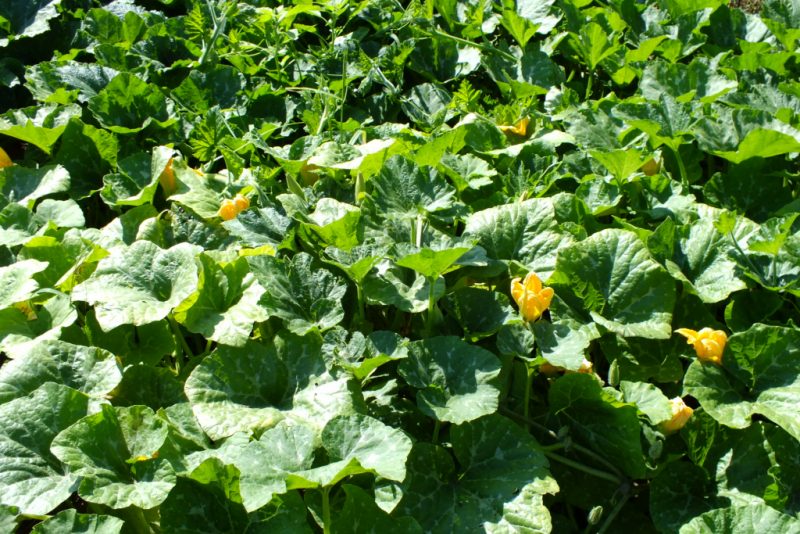
If for some reason fertilizers were not applied in the fall, this is done before sowing, pouring ½ bucket of manure into the hole, over which 5 cm of soil is distributed.
Several seeds are placed in each well:
- when sowing large-fruited varieties - from 2 to 5 pieces;
- nutmeg - from 5 to 8.
Seeds are placed at a distance of 3-4 cm, with “beaks” down.
The depth of their incorporation depends on the type of soil:
- for the lungs - 5 - 8 cm;
- heavy - 4 - 5 cm.
A plot with crops is mulched with peat or humus. Some gardeners cover the crops with film, after making small cuts in it for air to enter. This speeds up the emergence of seedlings.
Aftercare
With proper sowing and the use of quality seeds, the first pumpkin sprouts will appear in a week. They need care, which consists of watering, cultivating and feeding. With prolonged cloudy weather, additional measures are taken to prevent pests and diseases, as well as artificial pollination.
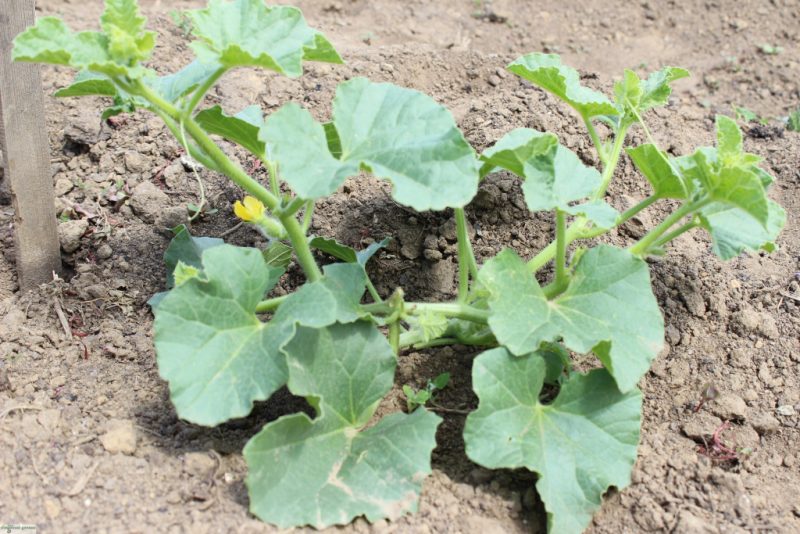
- Watering. Pumpkins are often and plentifully (10 liters under 1 plant) watered using water heated in the sun. The amount of moisture is increased as the leaves grow, promoting the evaporation of moisture, until the beginning of flowering. This measure promotes better fruit setting.
- Loosening. After emergence, regular soil loosening is practiced. Directly under the plant - to a depth of 6 - 8 cm, in row-spacings - 12 - 18 cm. After loosening, to give the plants more stability, the plants are slightly spud.
- Thinning. Pumpkin seedlings thin out twice. The first time - after the growth of the 2nd true leaf, leaving 2 plants each in the cultivation of nutmeg and hard-barked honeycombs in one well, one in large-fruited varieties.The next thinning is carried out after the appearance of the next pair of leaves. "Extra" plants are cut at soil level.
- Top dressing. To replenish the supply of nutrients spent on the formation of large leaves and fruits, pumpkin is regularly fed using organic fertilizers: infusions from manure or chicken manure (1: 4) or wood ash (1 glass per bucket of water). The first feeding is carried out about a month after sowing. The infusion is poured into the grooves with a depth of 6 - 8 cm, previously dug in a circle at a distance of 10 - 12 cm. Similar procedures are repeated weekly, gradually deepening the grooves to 10 - 12 cm and placing them at a distance of 40 cm from the plant. After top dressing, the grooves are covered with earth.
- Prevention of pests and diseases. During periods of prolonged coolness and frequent rains, the pumpkin weakens and can become ill or be attacked by pests. To strengthen immunity in such periods, the pumpkin is sprayed with a urea solution: 10 g in 10 liters of water.
- Pollination. If pumpkin flowering occurred during the period of cloudy weather, then it is pollinated artificially. They tear off a male flower (it is easy to distinguish it from a female by an elongated leg), break off the petals and touch the anthers of the pistils of the female flowers.
A little knowledge, attention, labor - and the pumpkin will delight you with its beautiful and healthy fruits. It will reign not only on the bed, but also on the table, supplementing and enriching the diet with useful substances that help to survive the winter without loss of health.












